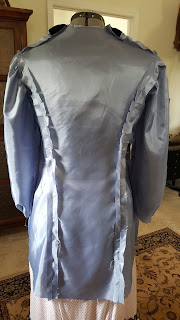Create an item that pays homage to fashion rebels and clothes that flaunt their place on the fringes of standard sartorial society, or that was signature to a rebelling cause.
The Dreamstress
Prior to 1795 women's fashions had retained a similar silhouette, with minor variations, for about 300 years. Following the French Revolution and the Reign of Terror in 1794, a new style emerged reflecting the Revolutionary belief in the values of republican Rome. Named from the French Revolutionary Government known as the Directory, Directoire style describes a brief transitional period from 1795 to 1799 in the decorative arts, fashion, and especially furniture design.
A cutaway jacket, or Directoire jacket, became popular during this period. The jacket was cut short in front with a long tailcoat back. The jacket style fell out of fashion around 1810. In the early 20th century French designers brought the style back into fashion and it was very popular during 1912 and 1913.
A cutaway jacket, or Directoire jacket, became popular during this period. The jacket was cut short in front with a long tailcoat back. The jacket style fell out of fashion around 1810. In the early 20th century French designers brought the style back into fashion and it was very popular during 1912 and 1913.
The Fashion Archaeologist developed a pattern from an early 1912 French design and offered the pattern under their Edwardian Rose Antique Patterns line.
The elegant shape of the jacket comes from the cut of the pieces. For the perfect drape I used a wool suiting fabric completely interlined (underlined) with silk organza, and lined with a very light faux silk fabric. There were many pieces and the day I had them finally cut and organized on my bed was a wonderful day!
The outer assembly begins with underlining each piece with the silk organza and then assembling them as instructed. The silk velvet cuffs and collar also underlined with silk organza and are pre-assembled and added.
The lining is assembled and includes the silk velvet lapel facings which are also underlined with silk organza.

The lining is stitched to the outer layer and a small opening left at the lower edge where the entire jacket is pulled through to its right side. The opening is slip-stitched closed. The interior of the cuffs is stitched to the lining.
The neckline is under-stitched by hand to prevent the lining from rolling outward when worn.

There are many small details, such as tacking the lining to the jacket in strategic places, that are all defined in the instructions. The sash/belt is constructed separately as part of the jacket. I covered buttons and added them to the jacket front and back and placed similar sized buttons on the skirt below the sash. This was the finished jacket in April.
I love this suit and wore it for an event in April. This past week I wanted to finish the suit according to the 1912 French illustration by adding the fringe to the collar. Since I had not added fringe to the collar prior, I stitched the fringe next to the seam and through each upper loop of the fringe.
What a beautiful addition! This is the suit for photos yesterday.
Historical Sew Monthly
The Challenge: #6 June - Rebellion and Counter-Culture
Material: Wool suiting, silk organza, silk velvet, faux silk lining
Pattern: Edwardian Rose Antique Patterns: Ladies 'Directoire' (Cutaway) Jacket
Year: 1912
Notions: Thread, buttons for covering, fringe
How historically accurate is it? Other than the synthetic lining, very accurate.
Hours to complete: 20 hours
First Worn: Worn in April, but finished this past week and worn for photos
Total Cost: $88.00 and $24.00 for pattern and shipping
Tasha Puppy likes the suit too!!
.jpg)







































































